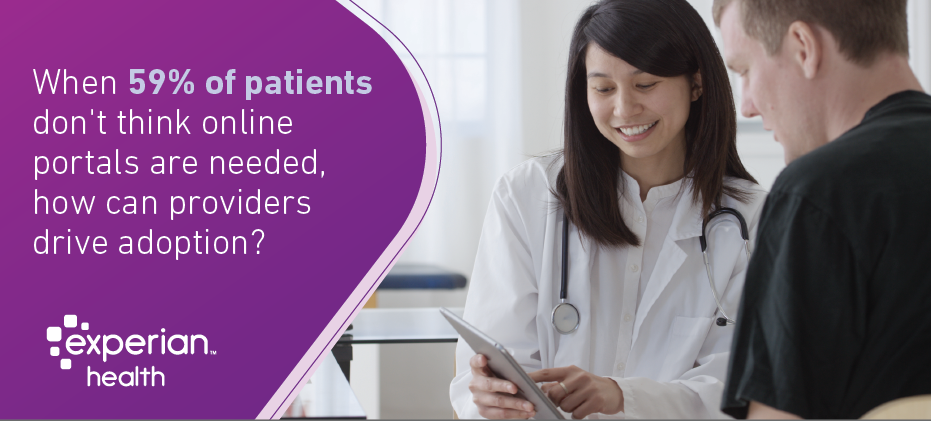
“Build it and they will come” might work for 1980s movie characters, multinational coffee franchises and beloved sports teams, but it’s not a great engagement strategy for most consumer-facing organizations – especially in healthcare.
Take patient portals, for example. Giving your patients a way to access their health records can help improve their health outcomes, increase compliance with care plans, and create a more positive healthcare experience overall. But do your customers know the portal exists? Do they know how it could serve them? Do they trust it?
You’ve built it, but how many patients are actually logging on?
In 2017, over half the US population had access to a patient portal. Around half of those people used it at least once in the previous year. Of those who didn’t, 59% said it was because they didn’t feel they needed to access an online medical record, and 25% were worried about privacy and security.
This tells us two things:
- If healthcare providers want to increase the number of patients using their portal, they need to proactively communicate the benefits to those patients, and
- healthcare providers could do more to reassure patients they take portal security seriously.
If patients discover that using the portal is better than not using it, and that they can do so securely, they will be more likely to log on. You can address both in your patient engagement and marketing strategies.
Perhaps the better mantra is: “if you solve their problem and tell them about it, they will come”.
Balancing portal security and patient convenience
Your patient portal is more than just a platform for patients to access test results, sort out bills or schedule appointments. It’s a way to nurture the patient-provider relationship. And at its heart, that relationship is about trust.
One way to build trust is to ensure your portal meets the strictest of security measures without creating an excessive admin burden for patients.
You can do this with a security strategy that layers up several protective measures to help you tackle common areas of vulnerability, including weak ID verification, over-reliance on password-protection, and failure to encrypt sensitive data.
A few practical ways to keep your patient portal secure include:
- using ID verification when someone signs up for the portal
- using device intelligence and identity proofing when a user signs in to the portal
- deploying extra security checks where the risk of identity fraud is higher
- putting systems in place to flag and respond to security breaches as fast as possible.
A solution like PreciseID® can help you take care of your patients’ privacy and security behind the scenes. They’ll see just enough to reassure them that you’re taking their security seriously, without any protracted log-in process that puts them off using the portal altogether.
Marketing your patient portal so more patients benefit from it
Solving your patients’ concerns about security is just one route to boosting portal utilization.
Another important way to ensure more patients use and benefit from the patient portal is to actively encourage them to access their online records regularly.
Research suggests individuals who are encouraged to use their online medical record by their provider are almost twice as likely to access it, compared to those who weren’t actively encouraged.
So how do you convince your patients of the benefits of regularly logging on? That it’s not just a convenient way to manage their medical journey, but could result in better health?
The answer lies in consumer data – the lifestyle, demographic, psychographic and behavioral information that gives you a fuller understanding of what drives your patients. Experian Health’s ConsumerView data analytics can capture insights that let you reach out to your consumers with the right message, in the right way, at the right time.
Do they live a busy lifestyle? Reassure them that the portal can save them time. Are there lifestyle factors that may hinder their adherence to medication? Encourage them to use the portal to make sure their prescriptions are up to date. If you discover your consumers are big social media users, you might target your portal engagement campaign through those channels. Equally, if a consumer doesn’t have any social media accounts, there would be no point investing in Facebook ads.
Personalization makes your patients feel taken care of, leading to greater trust, loyalty and satisfaction.
Increase patient portal engagement today
In the wake of consumerism and IT transformation across many other industries, a tailored and digitally secure healthcare service is a must.
“Consumers now expect to be provided with a turnkey, individual experience that is fast and seamless,” said Kristen Simmons, Experian Health’s senior vice president of strategy and innovation.
Your patient portal must be seen to provide a valuable and secure service.
While there’s a way to go to increase the number of patients making full use of portals, the tools exist to support healthcare providers’ engagement goals.
Learn more about how your organization can leverage consumer insights to improve patient retention and engagement.



